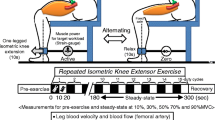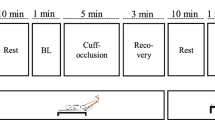Abstract
During dynamic exercise, the vasculature embedded within skeletal muscle intermittently collapses due to increased intramuscular pressure (IMP). The aim of this study was to ascertain whether oscillations in IMP during muscle contractions independently contribute to exercise training-induced increases in blood flow capacity (BFC). Based on IMP measurements during handgrip exercise, we attempted to mimic the action of repeated vascular compressions by using external inflatable cuffs. Thus, 24 healthy young male subjects underwent a 4-week program (5 days/week, 1 h/day) of application of external compressions of the non-dominant forearm, while the dominant limb served as an internal control. To evaluate the impact of compression pressures of different magnitudes, subjects were randomly assigned to one of three groups: 50, 100 and 150 mmHg of external compression. Prior to the intervention and after 2 and 4 weeks of treatment, we measured peak forearm blood flow (PBF) (Doppler ultrasound) and calculated peak vascular conductance (PVC) following 10 min of forearm ischemia. In the 50 and 100 mmHg groups, application of intermittent compressions did not alter PBF in either control or intervention forearms. In the 150 mmHg group, there was a trend (P = 0.04) for greater increases in PBF from baseline after 4 weeks in the intervention forearm compared to the control forearm (delta PBF: 4.2 ± 2.5 vs. −2.1 ± 2.0 (ml(100 ml)−1 min−1), in the intervention and control forearms, respectively), but the changes in PVC were not significant (P = 0.1). These findings suggest that repeated oscillations in IMP contribute minimally to exercise-induced increase in forearm BFC in healthy young humans.



Similar content being viewed by others
References
Allen JD, Geaghan JP, Greenway F, Welsch MA (2003) Time course of improved flow-mediated dilation after short-term exercise training. Med Sci Sports Exerc 35:847–853
Alomari MA, Welsch MA (2007) Regional changes in reactive hyperemic blood flow during exercise training: time-course adaptations. Dyn Med 6:1
Alomari MA, Welsch MA, Prisby RD, Lee CM, Wood RH (2001) Modification of forearm vascular function following short-term handgrip exercise training. Int J Sports Med 22:361–365
Alomari MA, Mekary RA, Welsch MA (2010) Rapid vascular modifications to localized rhythmic handgrip training and detraining: vascular conditioning and deconditioning. Eur J Appl Physiol 109:803–809
Barcroft H, Millen JL (1939) The blood flow through muscle during sustained contraction. J Physiol 97:17–31
Brown MD, Hudlicka O (2003) Modulation of physiological angiogenesis in skeletal muscle by mechanical forces: involvement of VEGF and metalloproteinases. Angiogenesis 6:1–14
Chen LE, Liu K, Qi WN, Joneschild E, Tan X, Seaber AV, Stamler JS, Urbaniak JR (2002) Role of nitric oxide in vasodilation in upstream muscle during intermittent pneumatic compression. J Appl Physiol 92:559–566
Franke WD, Stephens GM, Schmid PG 3rd (1998) Effects of intense exercise training on endothelium-dependent exercise-induced vasodilatation. Clin Physiol 18:521–528
Gray SD, Carlsson E, Staub NC (1967) Site of increased vascular resistance during isometric muscle contraction. Am J Physiol 213:683–689
Green DJ (2009) Exercise training as vascular medicine: direct impacts on the vasculature in humans. Exerc Sport Sci Rev 37:196–202
Green DJ, Cable NT, Fox C, Rankin JM, Taylor RR (1994) Modification of forearm resistance vessels by exercise training in young men. J Appl Physiol 77:1829–1833
Green DJ, Bilsborough W, Naylor LH, Reed C, Wright J, O’Driscoll G, Walsh JH (2005) Comparison of forearm blood flow responses to incremental handgrip and cycle ergometer exercise: relative contribution of nitric oxide. J Physiol 562:617–628
Hansen-Smith F, Egginton S, Zhou AL, Hudlicka O (2001) Growth of arterioles precedes that of capillaries in stretch-induced angiogenesis in skeletal muscle. Microvasc Res 62:1–14
Heffernan KS, Edwards DG, Rossow L, Jae SY, Fernhall B (2007) External mechanical compression reduces regional arterial stiffness. Eur J Appl Physiol 101:735–741
Hirche H, Raff WK, Grun D (1970) The resistance to blood flow in the gastrocnemius of the dog during sustained and rhythmical isometric and isotonic contractions. Pflug Arch 314:97–112
Hudlicka O (1998) Is physiological angiogenesis in skeletal muscle regulated by changes in microcirculation? Microcirculation 5:7–23
Kirby BS, Carlson RE, Markwald RR, Voyles WF, Dinenno FA (2007) Mechanical influences on skeletal muscle vascular tone in humans: insight into contraction-induced rapid vasodilatation. J Physiol 583:861–874
Kroese AJ (1977) Reactive hyperaemia in the calf of trained and untrained subjects: a study with strain gauge plethysmography. Scand J Clin Lab Invest 37:111–115
Laughlin MH, Ripperger J (1987) Vascular transport capacity of hindlimb muscles of exercise-trained rats. J Appl Physiol 62:438–443
Laughlin MH, Roseguini B (2008) Mechanisms for exercise training-induced increases in skeletal muscle blood flow capacity: differences with interval sprint training versus aerobic endurance training. J Physiol Pharmacol 59(Suppl 7):71–88
Laughlin MH, Newcomer SC, Bender SB (2008) Importance of hemodynamic forces as signals for exercise-induced changes in endothelial cell phenotype. J Appl Physiol 104:588–600
Lind AR, Williams CA (1979) The control of blood flow through human forearm muscles following brief isometric contractions. J Physiol 288:529–547
Newcomer SC, Leuenberger UA, Hogeman CS, Handly BD, Proctor DN (2004) Different vasodilator responses of human arms and legs. J Physiol 556:1001–1011
Newcomer SC, Sauder CL, Kuipers NT, Laughlin MH, Ray CA (2008) Effects of posture on shear rates in human brachial and superficial femoral arteries. Am J Physiol Heart Circ Physiol 294:H1833–H1839
Padilla J, Sheldon RD, Sitar DM, Newcomer SC (2009) Impact of acute exposure to increased hydrostatic pressure and reduced shear rate on conduit artery endothelial function: a limb-specific response. Am J Physiol Heart Circ Physiol 297:H1103–H1108
Padilla J, Young CN, Simmons GH, Deo SH, Newcomer SC, Sullivan JP, Laughlin MH, Fadel PJ (2010) Increased muscle sympathetic nerve activity acutely alters conduit artery shear rate patterns. Am J Physiol Heart Circ Physiol 298:H1128–H1135
Prior BM, Lloyd PG, Yang HT, Terjung RL (2003) Exercise-induced vascular remodeling. Exerc Sport Sci Rev 31:26–33
Prior BM, Yang HT, Terjung RL (2004) What makes vessels grow with exercise training? J Appl Physiol 97:1119–1128
Pyke KE, Poitras V, Tschakovsky ME (2008) Brachial artery flow-mediated dilation during handgrip exercise: evidence for endothelial transduction of the mean shear stimulus. Am J Physiol Heart Circ Physiol 294:H2669–H2679
Radegran G, Saltin B (1998) Muscle blood flow at onset of dynamic exercise in humans. Am J Physiol 274:H314–H322
Reading JL, Goodman JM, Plyley MJ, Floras JS, Liu PP, McLaughlin PR, Shephard RJ (1993) Vascular conductance and aerobic power in sedentary and active subjects and heart failure patients. J Appl Physiol 74:567–573
Reneman RS, Slaaf DW, Lindbom L, Tangelder GJ, Arfors KE (1980) Muscle blood flow disturbances produced by simultaneously elevated venous and total muscle tissue pressure. Microvasc Res 20:307–318
Roseguini BT, Mehmet Soylu S, Whyte JJ, Yang HT, Newcomer S, Laughlin MH (2010) Intermittent pneumatic leg compressions acutely upregulate VEGF and MCP-1 expression in skeletal muscle. Am J Physiol Heart Circ Physiol 298:H1991–H2000
Saltin B (1977) The interplay between peripheral and central factors in the adaptive response to exercise and training. Ann N Y Acad Sci 301:224–231
Sejersted OM, Hargens AR (1995) Intramuscular pressures for monitoring different tasks and muscle conditions. Adv Exp Med Biol 384:339–350
Sejersted OM, Hargens AR, Kardel KR, Blom P, Jensen O, Hermansen L (1984) Intramuscular fluid pressure during isometric contraction of human skeletal muscle. J Appl Physiol 56:287–295
Sinoway LI, Shenberger J, Wilson J, McLaughlin D, Musch T, Zelis R (1987) A 30-day forearm work protocol increases maximal forearm blood flow. J Appl Physiol 62:1063–1067
Snell PG, Martin WH, Buckey JC, Blomqvist CG (1987) Maximal vascular leg conductance in trained and untrained men. J Appl Physiol 62:606–610
Thijssen DH, Dawson EA, Tinken TM, Cable NT, Green DJ (2009) Retrograde flow and shear rate acutely impair endothelial function in humans. Hypertension 53:986–992
Tinken TM, Thijssen DH, Hopkins N, Dawson EA, Cable NT, Green DJ (2010) Shear stress mediates endothelial adaptations to exercise training in humans. Hypertension 55:312–318
Acknowledgments
The authors would like to thank Dr. Richard Madsen for assistance with statistical analysis. This research was supported by HL36088 and a Doctoral Student Research Grant from the American College of Sports Medicine Foundation (B.R.). Bruno Roseguini is a Fulbright/Brazilian Ministry of Education (Capes) fellow.
Conflict of interest
None.
Author information
Authors and Affiliations
Corresponding author
Additional information
Communicated by Narihiko Kondo.
Electronic supplementary material
Below is the link to the electronic supplementary material.
421_2010_1657_MOESM1_ESM.tif
Supplemental Fig. 1 Representative example of ultrasound image of the brachial artery (A) and raw velocity tracings at baseline (B) and during application of mechanical compressions at 50 mmHg (C), 100 mmHg (D) and 150 mmHg (E). Up arrows indicate the time when the cuff was inflated and down arrows denote the time when the cuff was deflated. Brachial blood velocity is given in cm/s (TIFF 624 kb)
Rights and permissions
About this article
Cite this article
Roseguini, B.T., Sheldon, R., Stroup, A. et al. Impact of chronic intermittent external compressions on forearm blood flow capacity in humans. Eur J Appl Physiol 111, 509–519 (2011). https://doi.org/10.1007/s00421-010-1657-6
Accepted:
Published:
Issue Date:
DOI: https://doi.org/10.1007/s00421-010-1657-6




